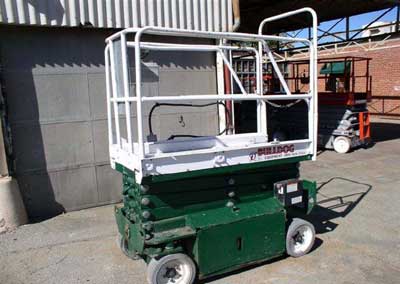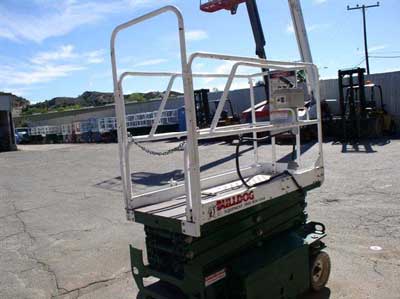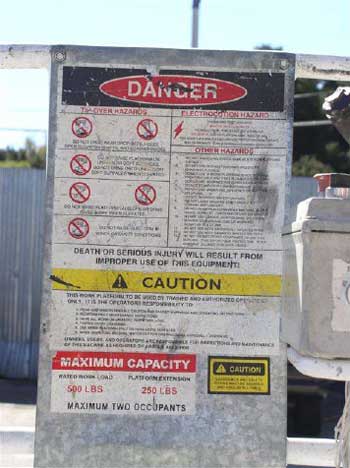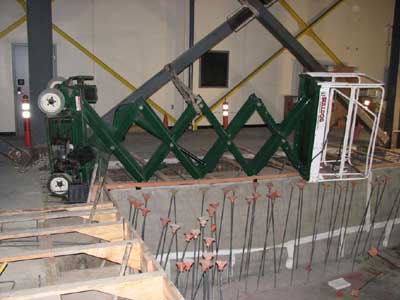A Welder Dies When the Scissor Lift He was Operating Tips Over
California Case Report: 09CA008
Summary
A 48-year-old welder died when the scissor lift he was operating tipped over and catapulted him out of the work platform against a concrete wall. The scissor lift was extended approximately 12 feet in height and tipped into an adjacent pit when moved by the victim in this elevated position. The only barrier between the scissor lift and the pit was an orange cone. The CA/FACE investigator determined that in order to prevent future incidents, employers using aerial lifts on construction work sites should ensure that:
- Employees perform a thorough hazard assessment and implement effective controls prior to using aerial lifts.
- Employees not maneuver scissor lifts forward or backwards while in the raised position.
In addition:
- Manufacturers should install safety interlocks that prohibit scissor lift travel while the platform is raised.
Introduction
On Monday, September 21, 2009, at approximately 4:15 p.m., a 48-year-old Hispanic welder died when he was catapulted out of a scissor lift that tipped over. The victim moved the scissor lift while he was in an elevated position, and it tipped over into a pit approximately three feet from the lift. The CA/FACE investigator was notified of this incident on September 21, 2009, by the Santa Ana District Office of the Division of Occupational Safety and Health (Cal/OSHA). On October 28, 2009, the CA/FACE investigator interviewed the company Human Resources Director and the attorney representing the company. On November 3, 2009, a representative of the scissor lift rental agency was interviewed and the scissor lift involved in the incident was inspected and photographed. On November 13, 2009, the incident site was inspected, and interviews were conducted with three facility personnel, the general contractor site project manager, and two workers who were at the site when the incident occurred. On December 28, 2009, telephone interviews were conducted with two co-workers and the victim’s supervisor.
The victim was born in Mexico and had been in California for 28 years. The victim had a college education and was fluent in English and Spanish. The employer of the victim was a company that specialized in structural steel, fabrication, erection, and miscellaneous steel products for the construction industry. The company had been in business for 13 years and had approximately 100 employees at the time of the incident. There were four employees working at the site when the incident occurred. The victim had been employed with the company for 10 years and was an experienced and certified welder. He had been working at this job site for one month when the incident occurred.
The employer had a written Injury and Illness Prevention Program (IIPP), with bilingual safety meetings that were held weekly and documented. The employer had an employee safety committee in which both management and employees participated. The employer had a training program that addressed machine operation and safety. Documented training was conducted in classroom settings and on-the-job training (OJT) at job sites. Employees were tested on their knowledge and operational skills of aerial lift equipment before being allowed to operate them. The victim in this case was tested, certified by the employer, and experienced in operating both articulating boom lifts and scissor lift equipment.
Investigation
The incident occurred inside a warehouse where steel frame supports were being erected for a second floor. A concrete pit was under construction on the ground floor and measured approximately 26 feet long by 5½ feet wide by 68 inches deep (26 x 5½ x 68). A pit perimeter was surrounded by a depression that measured 7½ inches deep by 36 inches wide (7½ x 36), with re-bar and concrete forms in place ready to be poured with concrete.
The machine involved in the incident was an electric self-propelled Condor scissor lift (model V1833XL) that was rented by another contractor on the work site. The scissor lift had a maximum platform height of 18 feet. The operating controls for the scissor lift were inside the work platform which measured 30 inches wide and 60 inches long. These controls allowed the operator to lift and lower the platform as well as move the entire lift forward and backward. There was no limit switch to prevent movement when the work platform was extended. There was no operating manual accompanying the scissor lift, but placards were attached inside the work platform detailing operational and safety instructions.
On the day of the incident, the victim was going to survey and weld some steel joints at the top of a steel frame that had just been erected. The employer of the victim had procured an articulating hydraulic boom lift for elevated work on this job. It was located within the warehouse on the other side of the pit. At the base of the steel frame that needed welding was a scissor lift. Instead of using the articulating hydraulic boom, the victim got into the scissor lift platform, maneuvered it into position, and then raised it to the height needed to access his work. The scissor lift was on a concrete floor that was level and straight. According to the general contractor, the distance from the steel beam to the edge of the depression of the pit was approximately 30 inches. The only barrier between the scissor lift and the depression of the pit was an orange cone on the concrete floor.
While in an elevated position, the victim moved the scissor lift forward to access his work. This movement caused the two front wheels of the scissor lift to roll into the depression of the pit. This momentum caused the entire scissor lift to topple forward onto the depression alongside the pit. The victim was ejected from the work platform headfirst, hit the opposite wall of the pit, and then fell to the pit floor. Several co-workers in the area ran to assist the victim. The paramedics and fire department responded within minutes and pronounced the victim dead at the scene.
Cause of Death
The cause of death according to the death certificate was contusion and laceration of the brain with skull fracture.
Recommendations/Discussion
Employers using aerial lift equipment on construction work sites should ensure that:
Recommendation #1: Employees perform a thorough hazard assessment and implement effective controls prior to using aerial lifts.
Discussion: In this particular incident, the victim needed to access a work area that was above and adjacent to a pit depression. An elevated work platform needed to be moved if the work area was to be fully accessible. In this incident a scissor lift was chosen to access the work area. There was a cone to communicate awareness of the pit depression, but the cone was not placed specifically to stop the scissor lift from moving towards this hazardous area. There were no engineering, administrative, or other controls that were implemented to prevent the scissor lift from falling into the pit. A task-specific hazard assessment would have identified the small distance between the pit depression and the scissor lift as a hazard requiring guards/barriers or other controls. A guard or barrier would have prevented the scissor lift from moving near the pit depression. An administrative control such as a spotter could warn the scissor lift operator when coming near to the pit depression. Had a thorough hazard assessment been performed and prevention measures implemented, this incident may have been prevented.
Recommendation #2: Employees not move scissor lifts forward or backwards while in the raised position.
Discussion: In this particular incident, the victim moved the scissor lift to access the work area while the platform was elevated. It is not known if the victim had been trained to avoid this procedure. While in the elevated position the center of gravity is higher, allowing the lift to more easily topple when the wheels encounter ground depressions or irregularities. Additionally, the operator may not be able to see the ground as well to determine if there is a hazard below. Had the victim lowered the work platform, he may have better seen the hazard below and not moved the scissor lift. In addition, even if he had moved the scissor lift and the wheels fell into the depression, he would probably have not been ejected from the platform and been killed. Employers can help ensure that workers not move scissor lifts while elevated through training, testing, supervision and progressive disciplinary measures.
Recommendation #3: Manufacturers should install safety interlocks that prohibit scissor lift travel while the platform is raised.
Discussion: In this particular incident, the scissor lift was capable of being moved forward and backward while in the elevated position. When the victim moved the scissor lift forward and the two front wheels rolled into the depression of the pit, this momentum caused the entire scissor lift to topple forward. A raised platform over a narrow base of support creates a long lever arm; and little force is required to turn over a fully elevated platform. This is why manufactures should install safety interlocks which would prohibit a scissor lift from traversing forward or backwards when the platform is raised. Most manufactures already equip their scissor lifts with a variety of safety interlocks such as those which limit platform height when the weight on the platform is excessive or off balance and others that will not allow the platform to be extended if the lift is on a significant incline. Adding another safety interlock that would prohibit lift travel when the platform is raised will prevent incidents such as this one from reoccurring.
Reference
- General Industry Safety Orders – Subchapter 7. General Industry Safety Orders: Group 4. General Mobile Equipment and Auxiliaries Article 24. Elevating Work Platforms and Aerial Devices §3646. Operating Instructions (Elevating Work Platforms). Group 6. Power Transmission Equipment, Prime Movers, Machines and Machine Parts Article 41. Prime Movers and Machinery §4002. Moving Parts of Machinery or Equipment.
- McCann, M. 2002. Aerial lift safety in construction. In Power Through Partnerships: 12th Annual Construction Safety and Health Conference, Proceedings (May 21-23, 2002, Rosemont, IL).
- California FACE Investigation 98CA003 April 27, 1998: www.cdc.gov/niosh/face/stateface/ca/98ca003.html
- NIOSH Publication No. 2003-139: Focus on Prevention: Conducting a Hazard Risk Assessment https://www.cdc.gov/niosh/mining/works/coversheet103.html (Link Updated 3/20/2013)
Exhibits

|
 |

|
 |
|
Exhibit 4. The incident scene.
|
California Fatality Assessment and Control Evaluation (FACE) Project
The California Department of Public Health, in cooperation with the Public Health Institute and the National Institute for Occupational Safety and Health (NIOSH), conducts investigations of work-related fatalities. The goal of the CA/FACE program is to prevent fatal work injuries. CA/FACE aims to achieve this goal by studying the work environment, the worker, the task the worker was performing, the tools the worker was using, the energy exchange resulting in fatal injury, and the role of management in controlling how these factors interact. NIOSH-funded, State-based FACE programs include: California, Iowa, Kentucky, Massachusetts, Michigan, New Jersey, New York, Oregon, and Washington.
To contact California State FACE program personnel regarding State-based FACE reports, please use information listed on the Contact Sheet on the NIOSH FACE web site. Please contact In-house FACE program personnel regarding In-house FACE reports and to gain assistance when State-FACE program personnel cannot be reached.
